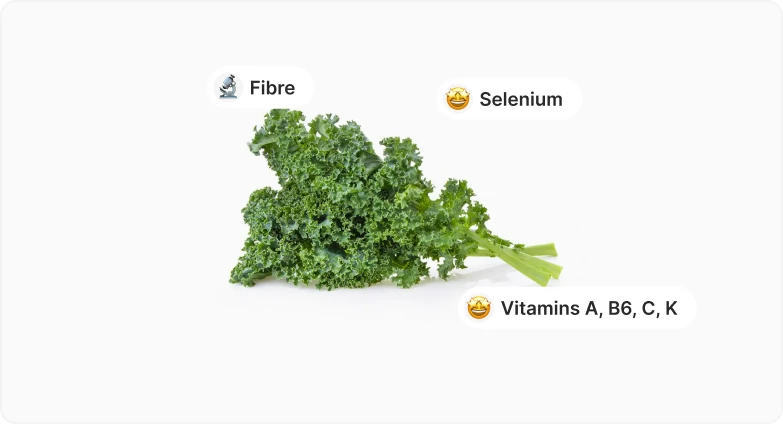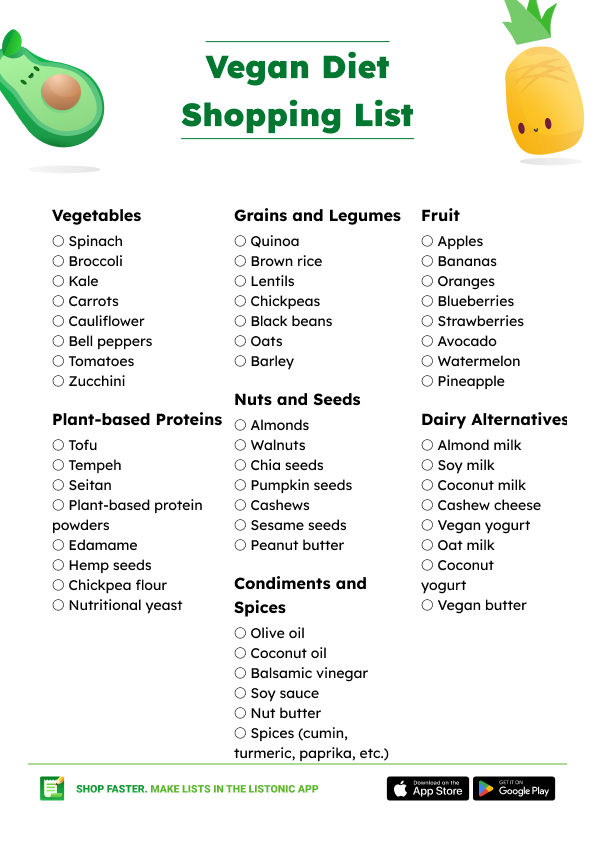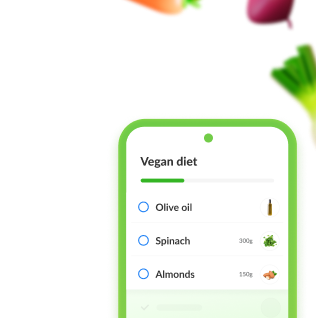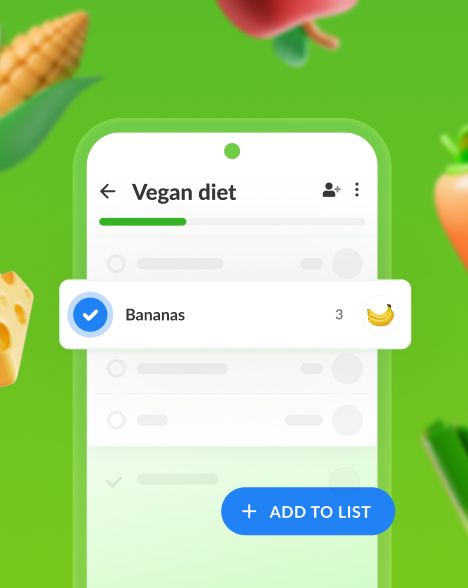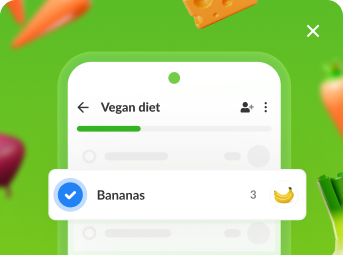Privacy Policy | Terms of services | Cookies Policy | © 2006-2024 Listonic. All rights reserved. Listonic Dev, and Listonic Ads are part of Listonic.
Vegan Diet Food List (+ Shopping List and PDF)
July 6, 2023
The vegan diet is a plant-based dietary lifestyle that excludes all animal products, including meat, dairy, eggs, and honey. In this article, we explore the core principles of the vegan diet and share practical tips to thrive on a balanced and nourishing vegan lifestyle. We also provide a handy shopping list to support you in navigating the vegan diet with ease.
Table of contents
Vegan Diet Shopping List
Vegan Diet Guidelines
Vegan Food List Breakdown
What Else to Keep in Mind?
Conclusions
Vegan Diet Shopping List
Vegetables
Fruit
Grains and Legumes
Nuts and Seeds
Plant-based Proteins
Dairy Alternatives
Condiments and Spices
Vegan Diet Guidelines
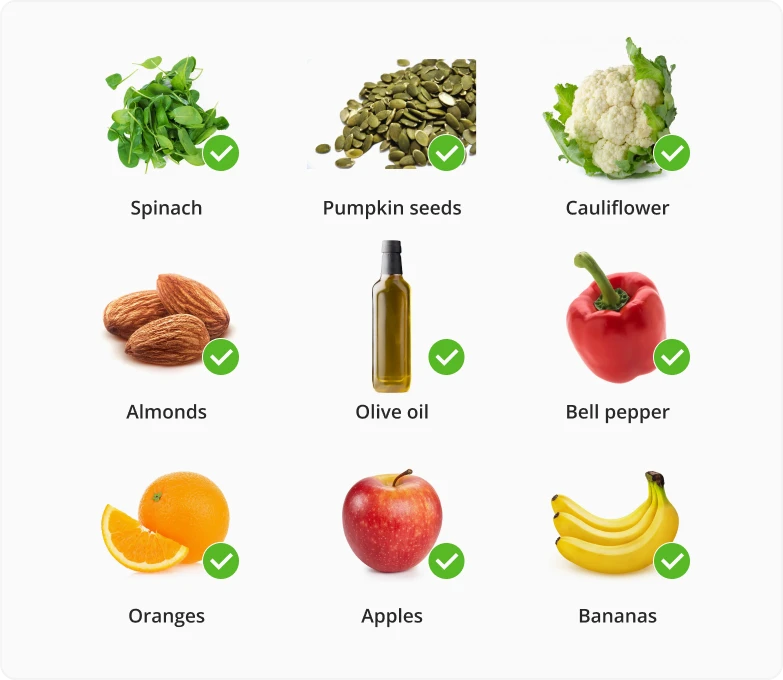
A vegan diet adheres to specific guidelines that center around consuming plant-based foods and excluding all animal-derived products, such as meat, dairy, eggs, and honey. To meet nutritional requirements, it is crucial to prioritize whole, unprocessed foods, including fruits, vegetables, whole grains, legumes, nuts, and seeds. These foods are rich in essential vitamins, minerals, fiber, and antioxidants.
Including protein-rich sources like tofu, tempeh, lentils, chickpeas, and quinoa can help ensure sufficient protein intake on a vegan diet. It is important to consider key nutrients typically found in animal products, such as vitamin B12, iron, calcium, and omega-3 fatty acids. Meeting these needs can be accomplished through fortified foods or supplements.
Calcium-rich plant-based sources like kale, broccoli, and fortified plant milks are beneficial, and for omega-3 fatty acids, incorporating flaxseeds, chia seeds, walnuts, or considering algae-based supplements is recommended.
It is worth noting that while a vegan diet offers a wide range of nutritious and wholesome plant-based foods, it also includes processed and unhealthy choices. Processed vegan junk foods can be part of the dietary plan but should be consumed in moderation to maintain a healthy lifestyle.
To ensure a well-rounded diet, it is beneficial to experiment with various cooking methods, flavors, and textures. Staying hydrated and paying attention to hunger and fullness cues are also essential practices to follow.
Vegan Food List Breakdown
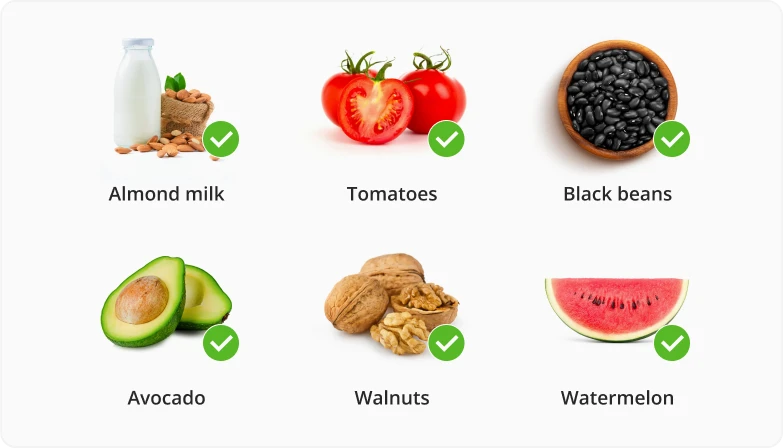
Grains and Legumes
Grains and legumes are essential components of a vegan diet as they provide a good source of carbohydrates, protein, fiber, and various vitamins and minerals. They include options like quinoa, brown rice, lentils, chickpeas, black beans, oats, barley, and buckwheat. These foods form the foundation of many vegan meals, offering versatility and nutritional benefits.
Incorporating a variety of grains and legumes into your diet ensures a well-balanced and satisfying plant-based eating experience.
Vegetables
Vegetables are key to a vegan diet, offering a wide range of nutrients, including vitamins, minerals, and fiber. They include leafy greens like spinach and kale, along with broccoli, carrots, cauliflower, bell peppers, tomatoes, and zucchini.
Vegetables can be enjoyed raw, steamed, roasted, or incorporated into various dishes, providing color, texture, and essential nutrients. Incorporating a variety of vegetables into your meals ensures a well-rounded and nourishing vegan diet, promoting overall health and vitality.
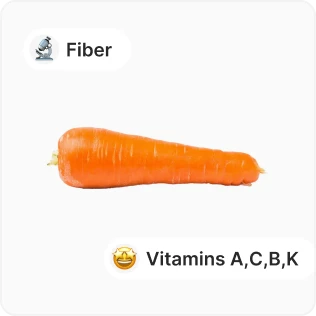
Fruit
Fruits are a vital part of a vegan diet, providing natural sweetness, fiber, and an array of vitamins and antioxidants. They include apples, bananas, oranges, berries, avocados, watermelon, and pineapple.
Fruits can be enjoyed fresh, in smoothies, salads, or desserts, adding refreshing flavors and contributing to overall health and well-being. With their diverse range of nutrients and flavors, fruits play a crucial role in meeting your nutritional needs while satisfying your sweet tooth.
Nuts and Seeds
Nuts and seeds are nutritious additions to a vegan diet, rich in healthy fats, protein, fiber, vitamins, and minerals. They include almonds, walnuts, chia seeds, flaxseeds, pumpkin seeds, cashews, sesame seeds, and peanut butter. These ingredients can be consumed as snacks, used in cooking or baking, or added to smoothies and salads to enhance flavor, provide texture, and offer a boost of nutritional value.
Plant-based Proteins
Plant-based proteins are crucial for vegans to meet their protein needs and include options such as tofu, tempeh, seitan, plant-based protein powders, edamame, hemp seeds, chickpea flour, and nutritional yeast. These protein sources are important for muscle repair, energy, and overall health, and can be used in a variety of dishes to replace animal-based proteins.
Dairy Alternatives
Dairy alternatives play a significant role in a vegan diet, providing substitutes for traditional dairy products. They include almond milk, soy milk, coconut milk, cashew cheese, vegan yogurt, oat milk, coconut yogurt, and vegan butter. These alternatives are used in cooking, baking, and as accompaniments, offering options for those who avoid animal-based dairy while providing taste and texture resemblances. Including dairy alternatives into your vegan diet allows for the enjoyment of creamy textures, rich flavors, and the ability to recreate favorite dairy-based dishes without using animal products.
Condiments and Spices
Condiments and spices add flavor and variety to vegan dishes. They include olive oil, coconut oil, balsamic vinegar, soy sauce, tahini, nut butter, maple syrup, and various spices like cumin, turmeric, and paprika. These ingredients enhance the taste and appeal of meals, allowing vegans to experiment with different flavors and create delicious plant-based dishes. By using condiments and spices, you can elevate the flavor profile of your vegan meals, making them more satisfying and enjoyable.
Get a Vegan Diet Grocery List on Your Phone!
Add & remove items
Sort items by store aisles
Share the list with your partner

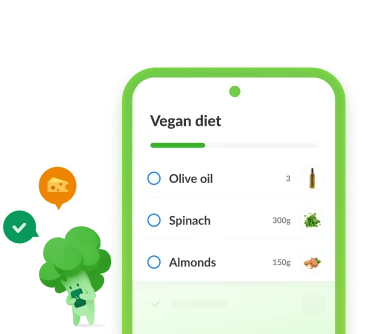
What Else to Keep in Mind?
What Foods to Avoid?
A vegan diet follows specific guidelines that revolve around consuming plant-based foods while excluding all products of animal origin. This includes avoiding:
Meat: All types of animal flesh, such as beef, pork, chicken, turkey, and seafood. Animal fats (such as lard and tallow) are also excluded from a vegan diet.
Dairy Products: Milk, cheese, yogurt, butter, cream, and any products made from animal milk.
Eggs: Eggs in any form, including scrambled eggs, omelets, and baked goods containing eggs.
Honey: Since honey is produced by bees, it is not considered a vegan option.
Gelatin: Derived from animal bones and connective tissues, it is commonly found in desserts, marshmallows, and some processed foods.
Animal-Derived Additives: Some food additives are derived from animals. These include ingredients like gelatin, rennet (used in cheese production), casein, whey, lactose, and albumin; as well as certain colorings (e.g. cochineal or carmine), food glazes (e.g. shellac) and flavorings.
Animal-Based Condiments: Condiments and sauces that contain animal-derived ingredients, such as Worcestershire sauce (contains anchovies), oyster sauce (contains oysters), and fish sauce.
Beeswax and Propolis: Beeswax and propolis are non-vegan ingredients often found in cosmetic and pharmaceutical products.
Animal-Based Supplements: Supplements such as fish oil capsules and gelatin-based vitamin capsules.
In addition to food choices, many vegans also avoid other animal-derived products, such as leather, fur, silk, and wool, due to ethical or environmental reasons.
How to add more protein to a vegan diet?
Contrary to popular belief, a vegan diet can meet your protein needs if properly balanced. Here are some ways to increase protein intake on a plant-based diet:
Legumes: Include beans, lentils, and chickpeas in most of your meals. They are versatile and can be used in soups, stews, salads, or made into spreads like hummus.
Soy-Based Foods: Incorporate tofu, tempeh, and edamame, which are excellent sources of plant-based protein. They can be grilled, stir-fried, or added to various dishes.
Seitan: Incorporate seitan, a meat substitute made from wheat gluten, into your meals. It has a chewy texture and can be used in stir-fries, sandwiches, and stews.
Whole Grains: Opt for protein-rich grains like quinoa, amaranth, and buckwheat. These grains can be used as a base for salads, added to soups, or enjoyed as a side dish.
Nutritional Yeast: Nutritional yeast is a deactivated yeast that provides a cheesy flavor and additional protein.
Plant-Based Protein Powders: Consider using plant-based protein powders, such as pea protein, hemp protein, or rice protein, as a convenient way to increase protein intake. They can be added to smoothies or used in baking recipes.
How to add more calcium to a vegan diet?
Ensuring adequate calcium intake is important for maintaining strong bones and overall health, and incorporating calcium-rich foods into a vegan diet is essential. Here are some calcium-rich products you can include in your plant-based meals:
Calcium-Fortified Foods: Opt for calcium-fortified products, such as plant-based milk and yogurt, breakfast cereals, or tofu. Check the labels to ensure they contain added calcium.
Sesame Seeds and Tahini: Sprinkle sesame seeds on salads or use tahini (sesame seed paste) as a dressing or dip. They are excellent sources of calcium.
Legumes and Beans: Include calcium-rich legumes and beans like chickpeas, black beans, and white beans in your meals. They not only provide protein but also contribute to your calcium intake.
Vegan Diet Lunch Ideas
Buddha Bowl: Create a nourishing bowl with a base of quinoa or brown rice, topped with a colorful medley of roasted veggies like sweet potatoes, broccoli, and bell peppers. Add a protein source like chickpeas or tofu, and drizzle it with a tangy dressing for a flavorful experience.
Vegan Wrap: Take a tortilla or lettuce leaves as your basis, and layer on creamy hummus, avocado, crunchy carrots, cucumber, and sprouts. Add marinated tofu or tempeh for extra protein and roll it up for a satisfying lunch.
Lentil Salad: Freshen up with a zesty lentil salad. Combine cooked lentils with tomatoes, cucumbers, red onions, and herbs. Sprinkle it with a mixture of nuts and seeds for a nice crunch. Dress it with lemon juice and olive oil for a light and delicious lunch option.
Veggie Stir-Fry: Stir-fry a colorful mix of bell peppers, broccoli, snap peas, and mushrooms in a mouthwatering tahini and soy sauce. Serve over rice or noodles for a quick and flavorful vegan lunch.
Chickpea Salad Sandwich: Experience a sandwich sensation! Mash chickpeas with vegan mayo, lemon juice, and spices. Spread it on bread and top with tomatoes, lettuce, and avocado for a protein-packed delight.
Conclusions
Adopting a vegan diet can have remarkable benefits for your health and overall well-being. By prioritizing plant-based foods, a vegan diet offers a nourishing and sustainable approach to eating.
To assist you in embracing a vegan lifestyle, we have provided a comprehensive shopping list that encompasses a wide variety of vegan-friendly ingredients. Feel free to use it either as a PDF or in a digital form. Enjoy!
